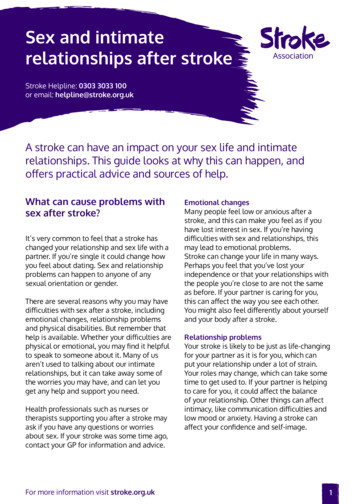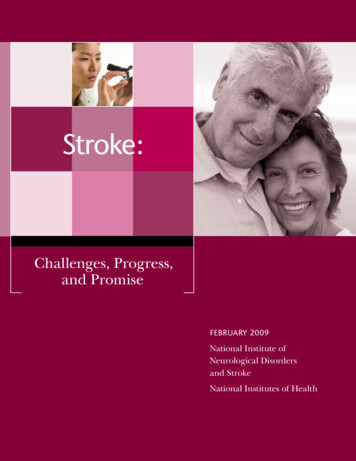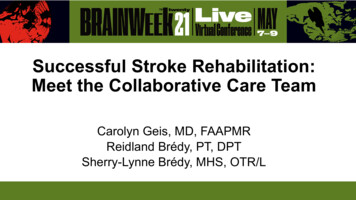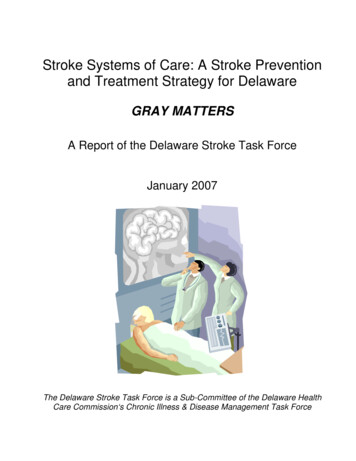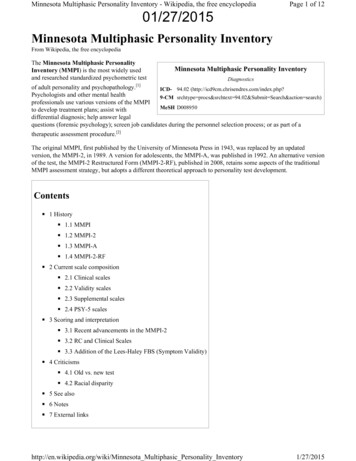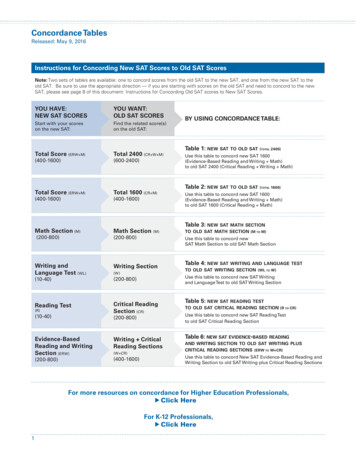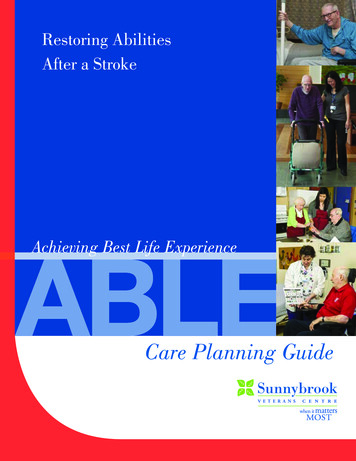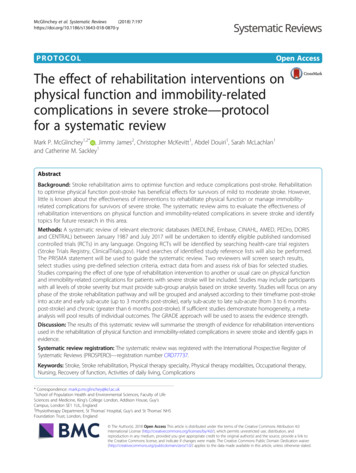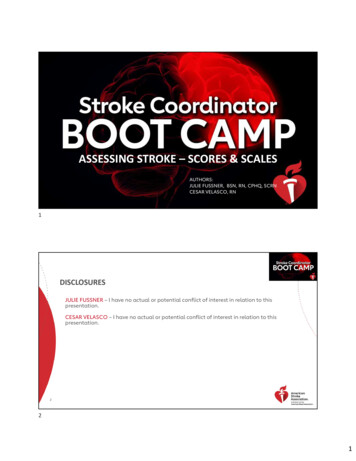
Transcription
ASSESSING STROKE – SCORES & SCALESAUTHORS:JULIE FUSSNER, BSN, RN, CPHQ, SCRNCESAR VELASCO, RN11DISCLOSURESJULIE FUSSNER – I have no actual or potential conflict of interest in relation to thispresentation.CESAR VELASCO – I have no actual or potential conflict of interest in relation to thispresentation.221
OBJECTIVESSTROKE SCALES Discuss the most current, relevant scoring systems and scales being used for the strokepopulation Identify the strengths, limitations, and application of these scales Recognize each scoring system and scale property that is important and relevant to allassessment tools33WHY ARE SCORING SYSTEMS AND SCALES USED?Assess the impact of therapeutic interventions in researchAids in improving diagnostic accuracyHelps determine clinical pathways of treatmentSeverity measurementHandoff CommunicationAssists in predicting and evaluating a patient’s clinical outcomeA “ONE SIZE FITS ALL” APPROACH DOES NOT APPLY TO STROKE EVALUATION AND TREATMENT.442
SCORING SYSTEMS AND SCALESPREHOSPITAL STROKE ASSESSMENT SCALES Cincinnati Prehospital Stroke Scale (CPSS)OUTCOME ASSESSMENT SCALES Los Angeles Prehospital Stroke Scale (LAPSS) Barthel Index Rapid Arterial oCclusion Evaluation Scale(RACE) Glasgow Outcome ScaleACUTE ASSESSMENT SCALESOTHER DIAGNOSTIC & SCREENING TEST Glasgow Coma Scale (GCS) Hachinski Ischaemia Score NIH Stroke Scale (NIHSS) Hamilton Rating Scale for Depression Intracerebral Hemorrhage Scale (ICH)FUNCTIONAL ASSESSMENT SCALES Berg Balance Scale5 Modified Rankin Scale (mRS)5DEFINITIONSSENSITIVITY Sensitivity also called the true positive rate measures the proportion ofactual positives that are correctly identified Refers to a test's ability to designate an individual with disease aspositive. A highly sensitive test means that there are few false negative results,and thus fewer cases of disease are missed.SPECIFICITY Specificity also called the true negative rate measures the proportionof actual negatives that are correctly identified The percentage of healthy people who are correctly identified as nothaving the condition6 Specificity avoids false positives63
PREHOSPITAL STROKE ASSESSMENT SCALESCINCINNATI PREHOSPITAL STROKE SCALE (CPSS) Identifies facial paresis, arm drift, and abnormal speech. 80% of stroke patients will exhibit one or more of these symptoms. However, it has the same limitations for certain stroke-relateddeficits that can occur in isolation. Does not identify posteriorcirculation strokes Strength: Quick and easy for EMS to use77884
PREHOSPITAL STROKE ASSESSMENT SCALES (CONTINUED)LOS ANGELES PREHOSPITAL STROKE SCALE (LAPSS) Assesses for unilateral deficit facial paresis, hand grip weakness, and arm drift Pre-hospital stroke screening criteria:1.2.3.4.5.Patient is 45 years of ageHas no history of seizure/epilepsySymptom duration is 24 hoursPatient is not bedridden or wheelchair dependent at baselineBlood glucose is between 60-400 mg/dL. Sensitivity 91% and Specificity 97% Strength: Allows rapid identification while excluding common mimics Limitation: Number of items for EMS to complete9910105
PREHOSPITAL STROKE ASSESSMENT SCALES (CONTINUED)SEVERITY SCALES FOR LARGE VESSEL OCCLUSION2018 AHA Guidelines: Uncertainty exists over optimal algorithm and optimal prehospital LVOscreen RACE: Rapid Arterial Occlusion Evaluation“Off hand,say your LAMS: Los AngelesMotorI’dScalesuffering from an arrow FAST-ED: FieldAssessmentthroughyour Strokehead, Triage for Emergency Destinationbut just to play it safe,I’m going to conducta bunch Neglectof VAN: Vision, Aphasia,Assessmentassessments. CSTAT: Cincinnati Prehospital Stroke Severity Scale MEND: Miami Emergency Neurologic Deficit ROSIER: Recognition of Stroke in the Emergency Room1111PREHOSPITAL STROKE ASSESSMENT SCALES (CONTINUED)SEVERITY SCALES FOR LARGE VESSEL OCCLUSIONWhy you can’t have a perfect scale: Up top 29% of patient with baseline of NIHSS 0 had a proximal occlusion on CTA Most scales are subsets of NIHSS scores Patients with ICH, post seizure paralysis, hyperglycemia in the field can have high NIHSS12126
PREHOSPITAL STROKE ASSESSMENT SCALES (CONTINUED)RAPID ARTERIAL OCCLUSION EVALUATION SCALE (RACE) This tool is based on the items of the NIHSS with the highestpredictive value for large vessel occlusion (LVO). Focuses on facial palsy, extremity motor function,head and gaze deviation, and aphasia or agnosia. The RACE scale score range is 0-9 points RACE scale score 5 points is associated with detection of aLVO RACE has as a sensitivity of 85% and specificity of 68%1313RAPID ARTERIAL OCCLUSION EVALUATION SCALE (RACE)ITEMINSTRUCTIONSCOREFacial palsyAsk patient to smileAbsent 0Mild 1Moderate to severe 2Arm motor functionExtend patient’s arm 90Normal to mild 0degrees if sitting; 45 degrees if Moderate 1supineSevere 2Leg motor functionExtend patient’s leg 30degrees in supine positionNormal to mild 0Moderate 1Severe 2Head and gaze deviationObserve deviation to one sideAbsent 0Present 1Aphasia (right side)Ask patient to close their eyesand make a fistNormal 0Moderate 1Severe 2Agnosia (left side)Ask patient to recognizefamiliar objectsNormal 0Moderate 1Severe 214147
ACUTE ASSESSMENT SCALESGLASGOW COMA SCALE (GCS) Identifies ocular, verbal, and motor response to examination Tool is used to communicate the level of consciousness (LOC)of patients with an acute brain injury The scale was developed to complement and not replaceassessments of other neurological functions Strength: Fast and easy to use Limitation: Developed as a trauma scale. Stroke patient with plegicarm can be scored a 6 on the motor response if they followcommands151516168
ACUTE ASSESSMENT SCALES1717ACUTE ASSESSMENT SCALESNATIONAL INSTITUTES OF HEALTH STROKE SCALE (NIHSS) Uses a 11 Item scale to measure neurological impairment Originally developed to be a research tool for Alteplasepatients to determine 90 day outcomes NIHSS has become the “gold standard” scale in clinical trialsand as part of clinical practice in the United States Baseline NIHSS scores are predictive values of an acute strokepatient’s clinical outcomes Quality metric for PSC, TSC and CSC Certifications Score what the patient does, not what you think they can do18189
NATIONAL INSTITUTES OF HEALTH STROKE SCALE (NIHSS)Scoring range is 0-42 points.The higher the number, thegreater the severity.Score0Stroke SeverityNo stroke symptoms1-4Minor stroke5-15Moderate stroke16-20Moderate to severe stroke21-42Severe stroke1919ACUTE ASSESSMENT SCALESNATIONAL INSTITUTES OF HEALTH STROKE SCALE (NIHSS) Strength: Reliable tool to rapidly assess effects of strokeMedical providers and registered nurses expertly trained in theuse of the scale are proven to have similar levels of accuracyFurther reliability improved through the use of a standard training video Limitation: Tool does not capture ALL stroke-related impairmentsUnsteady gait, dizziness, or diplopia attributed toposterior circulation strokeMore complicated with patient in coma, intubated or aphasic202010
ACUTE ASSESSMENT SCALESINTRACEREBRAL HEMORRHAGE SCALE(ICH SCORE) Uses a 5-item scale Predictor of 30 day mortality Developed to standardize clinicalgrading to improve communicationand consistency between healthcareproviders. Sensitivity 66% in predicting 30 daymortality2121FUNCTIONAL ASSESSMENT SCALESBERG BALANCE SCALE (BBS) 14-item scale designed to measure the balance of older patients in the clinicalsetting Scoring range is 0-4 points. The greater the number, the higher the level of function.Patient with a score 55 and history of falls is at a greater risk of falling41-56 IndependentPatient with a score 40 has a 100% risk of falling21-40 Walking with assistance0-20 Wheelchair bound Sensitivity 91% and Specificity 82%222211
2323FUNCTIONAL ASSESSMENT SCALESMODIFIED RANKIN SCALE(mRS) 7-grade scale measuring functional independence and gaitstability mRS has been used to measure stroke outcomes andfunctional impact post-stroke The scale is used a “core metric” of Comprehensive StrokeCenters; evaluating 90-day clinical outcomes of post-IV tPA(Alteplase) or endovascular intervention (EVT) patients A mRS score appears to show moderate correlation with thevolume of cerebral infarction Good Outcome: 0-2242412
2525OUTCOME ASSESSMENT SCALESBARTHEL INDEX (BI) The index measures 10 basic aspects of self-care and patient’s physicaldependency. A normal Barthel Index score 100 60 Assisted independence 40 Severe dependency Strength: An excellent validity and reliability rate and widely used for stroke. Limitation: A low sensitivity for high-level functioning or chronically disabled.262613
BARTHEL ADL INDEX: GUIDELINES1.The index should be used as a record of what apatient does, not as a record of what a patientcould do.2.The main aim is to establish degree ofindependence from any help, physical orverbal, however minor and for whatever reason.3.The need for supervision renders the patient notindependent.4.A patient’s performance should be establishedusing the best available evidence. Asking thepatient, friends/relatives and nurses are theusual sources, but direct observation andcommon sense are also important. However,direct testing is not needed.5.Usually the patient’s performance over thepreceding 24-48 hours is important, butoccasionally longer periods will be relevant.6.Middle categories imply that the patientsupplies over 50% of the effort.7.Use of aids to be independent is allowed.2727OUTCOME ASSESSMENT SCALESGLASGOW OUTCOME SCALE (GOS) Global scale evaluating functional outcome of patients status post traumatic braininjury GOS predicts the long-term course of rehabilitation to return to work and everydaylife The scale rates a patient’sstatusin withoutone ofrecoveryfive categories:Severe injuryor deathof consciousness Death Vegetative state Severe disability Moderate disabilitySevere damage with prolonged state of unresponsiveness; lack of mental functionsSevere injury with permanent need for help with daily livingNo need for assistance, employment is possible but may require special equipmentLight damage with minor neurological and psychological deficits Good recovery282814
2929OTHER DIAGNOSTIC & SCREENING SCALESHACHINSKI ISCHAEMIA SCORE (HIS) 13-item scale used for differentiating various types of dementia A high HIS score of 7 or greater vascular dementia A low HIS score of 6 or less a non-vascular dementia neurological change Valid in predicting a true diagnosis based on acceptable sensitivity and specificitydefining vascular dementia. Research suggests that high HIS scores may indicate the presence of anothervascular factor, such as stroke, as the cause for a patients decrease in cognitivefunction303015
3131OTHER DIAGNOSTIC & SCREENING SCALESHAMILTON RATING SCALE FOR DEPRESSION (HAM-D) 17-item questionnaire used to evaluate for depression and evaluate apatient’s recovery status. Score of 0-7 is normal while a score of 20 or high is indicating a leastmoderate severity Designed for adults and rates the severity of individual patientdepression by examining; mood, feelings of guilt, thoughts of suicide,insomnia, agitation, cognitive delay, anxiety, loss of weight, andsomatic symptoms. Limitation: Focuses on insomnia; rather than feelings of hopelessness,suicidal ideation or action.323216
3333343417
WHAT SCALE TO USE? Most Common:CPSNIHSSmRSBarthel No one scale fits every situation Which scale you use should be based on the questionyou are trying to answer and the scales properties. They do not always tell the whole story3535THANK YOU363618
REFERENCESBeck, A., Ward, C., Mendelson, M., Mock, J., And erbaugh, J. (1961). An inventory for measuring depression. Arch gen psychiatry; 4:561-71.Beck, a. And steer, R. (1987). Beck depression inventory: manual (revised edition). NY psychological corporation.Bonita, R. and Beaglehole, R. (1988). Recovery of motor function after stroke. Stroke; 19:1497-1500.Bruno, A., Shah, N., Lin, C., Close, B., Hess, D., Davis, K., et al. (2010). Improving Modified Rankin Scale assessment with a simplified questionnaire. Stroke; 41:1048-1050.doi: 10.1161/STROKEAHA.109.571562Goldstein, L. (2019). Use and utility of stroke scales and grading systems. Up To Date. Retrieved from of-stroke-scales-and-gradingsystemsMaas, M., Furie, K., Lev, M., Ay, H., Singhal, A., Greer, D., et al. (2009). National Institutes of Health Stroke Scale score is poorly predictive of proximal occlusion in acute cerebral ischemia.Stroke; 40:2988-2993. doi: 10.1161/STROKEAHA.109.555664Mahoney, F. and Barthel, D. (1965). Functional evaluation: The Barthel Index. Maryland State Medical Journal; 14:56-61.Powers, W., Rabinstein, A., Ackerson, T., Adeoye, O., Bambakidis, N., Becker, K., et al. (2018). 2018 Guidelines for the early management of patients with acute ischemic stroke: A guidelineforhealthcare professionals from the American Heart Association/American Stroke Association. Stroke; 49:e46-e99. doi: 10.1161/STR.0000000000000158Radloff, L. (1977). The CES-D scale: A self-report depression scale for research in the general population. J appl psychol meas; 1:385-401.Ver hage et al. (2011). The NIH stroke scale: A window into neurological status. Nurse.com. Nursing Spectrum; 24:44-49.Yesavage, j., Brink, T., Rose, T., Lum, O., Huang, V., Adey, M., And leirer, V. (1983). Development and validation of a geriatric depression screening scale: A preliminary report.J psychiatr res; 17:37-49.373719
LOS ANGELES PREHOSPITAL STROKE SCALE (LAPSS) Assesses for unilateral deficit facial paresis, hand grip weakness, and arm drift Pre-hospital stroke screening criteria: 1. Patient is 45 years of age 2. Has no history of seizure/epilepsy 3. Symptom duration is 24 hours 4. Patien


